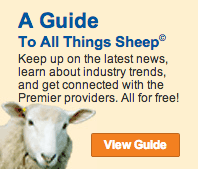
PREMIER PICKS
Breeding Harnesses and Crayons
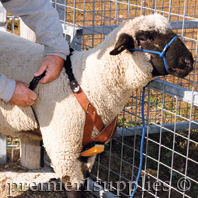
Cross Your Heart Breeding Harness. Most users need to re-adjust the harness weekly (active rams lose weight during breeding). Change crayon colors to record which week ewes were marked. The blue braided halter was used to restrain the ram so Mike (shepherd) could adjust the harness.
Premier offers two breeding harnesses:
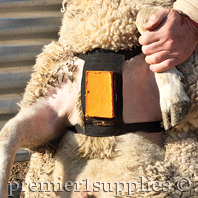
Shows the yellow marking crayon and how the nylon breeding harness should look when on the ram.
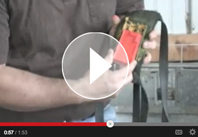
Click above to view our "how-to replace crayons on a ram marking harness".
See article "Preparing for Breeding Season" on our Guide.
HELPFUL RESOURCES
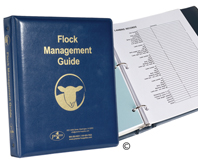 Flock Management Guide
Flock Management Guide
For the busy farm manager/record keeper. Prepared by the folks at Premier in response to requests from shepherd customers.
Guide sections include workable and timesaving information (with space for your notes) about feeding, lambing, shearing, wool sales, lamb inventories and sales, breeding, record keeping, health and much more.
See our other helpful guides & books.
LAMBING CALENDAR
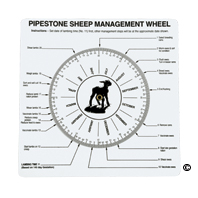 Sheep Management Wheel
Sheep Management Wheel
Takes the guesswork out of shepherding. Set your desired lambing date and your shepherding schedule for the year falls into place.
RECIPE
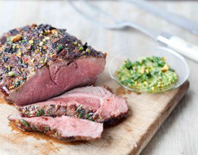 Grilled Butterflied American Lamb Leg
Grilled Butterflied American Lamb Leg
| • |
3 pounds butterflied American Lamb leg
|
| • |
Salt and pepper, to taste
|
Lay lamb leg open on a cutting board. Trim off visible fat. Season lamb generously with salt and pepper; allow to sit at room temperature for 30 minutes prior to grilling.
Preheat grill to medium-high. Grill the lamb leg to medium-rare (remove from heat when thermometer reads between 130°F and 135°F), or to desired doneness. Rest the meat, lightly covered, for at least 10 minutes before serving. Slice meat across the grain into thin slices.
Serve lamb with the Mint-Pistachio Pesto, grilled vegetables and a salad.
See Mint-Pistachio Pesto on our "Guide"
See more lamb recipes on our Guide to All Things Sheep.
|
 |
 |
Comments Requested for Lamb Industry Study
Hi folks,
In response to the decades of decline (from 50 million sheep to 5 million in 50 years) by the USA sheep industry the American Lamb Board (of which I'm a member) commissioned a study by an independent, outside firm to determine what needed to be done to turn this trend. The Hale Group was selected to do this and is being lead by Robert Ludwig.
The study began in January. It released its interim/progress report in July. Click here to read the report.
They are now seeking input and comments about this report from any and all sheep producers—be they large or small, be they in the East or West, be they fiber producers, seed stock producers, show sheep owners, farm flock owners or large commercial range sheep owners.
This is a unique moment in time in which your input can make a difference. I encourage you to step forward if you've not already done so. All of us have until August 26 (date of the meeting) to provide comments—but earlier is better.
If you wish to comment, email Robert Ludwig.
Taken from the American Lamb Board August Newsletter:
Lamb Industry Roadmap Advisory Group Schedules Final Meeting
The Lamb Industry Roadmap Advisory Group has scheduled its final meeting for Aug 27 and 28 in Denver. There they will finalize and add details to their recommendations, which will include an implementation plan with specific action steps and deadlines for completion.
The group is seeking widespread input from all segments of the industry before it adopts its final recommendations and urges all the industry to carefully review the Progress Report at lambcheckoff.com. The Advisory Group wants to gather input from as many participants as possible before finalizing recommendations at their August meeting.
|
Best Wishes to you all,
Stan Potratz
|
PREPARE FOR LAMBING
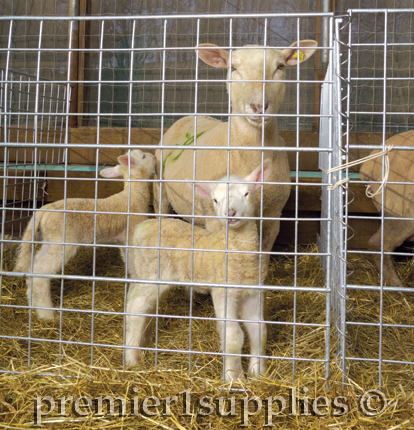
The goal of breeding season: healthy lambs and a healthy mom. Our lambing jugs are made with PowerBilt® panels and can be quickly adapted to any size lambing barn.
Lambing for the high points in the market...
The breeding season for Premier sheep started 3 weeks ago and will continue through December. Lambing will begin early December and go on into April. Why are we doing this? By producing lambs over a larger window, we will be better able to have lambs ready during peak periods in the market. This allows us to produce lambs that will be ready for multiple markets. To accomplish this, we need to keep accurate and complete management records so we know when to bring which ewes in from pasture to lamb.
Below is an excerpt from Storey's Barn Guide to Sheep.
Shepherd's Calendar
May
| • |
Check your fences before bringing home new sheep.
|
| • |
Check your pasture for toxic plants.
|
| • |
Give new sheep hay before turning them onto lusher pasture than they are used to.
|
| • |
Check for keds and treat your sheep if you see even one ked.
|
June
| • |
Practice pasture rotation.
|
| • |
Provide plenty of water, salt, and mineral/vitamin mix.
|
| • |
Watch for fly-strikes (cluster of tiny eggs) and maggots.
|
| • |
Keep rear ends trimmed to discourage flies.
|
July
| • |
Provide shade for your sheep in hot weather.
|
| • |
Provide 1 to 2 gallons of cool, fresh water daily for each adult sheep
|
| • |
Check the feet of limping sheep; trim hooves if necessary.
|
| • |
Check for parasites by fecal count and deworm if necessary. Record data of deworming.
|
If you are planning for fall breeding:
| • |
Put your ram in a shaded area near the ewe.
|
| • |
Shear the ram’s scrotum to keep him cool.
|
| • |
Start flushing the ewe before you plan to bring in the ram for breeding.
|
| • |
Body-condition ewes.
|
August
| • |
Continue to provide shade.
|
| • |
Consider necessary parasite prevention and deworm if necessary.
|
| • |
Consider purchasing hay and/or grain for winter. Store grain in rodent-proof containers that sheep cannot get into.
|
If you are planning for January lambing:
| • |
For early lambs, keep the ram in a shady place during the day and bring him in at night.
|
| • |
Maintain ram condition; give him 1/4 - 1/2 pound of grain daily if necessary.
|
| • |
Keep the ram with your ewe for at least 6 weeks so they have two chances or more for mating. A marking harness on the ram will indicate that mating is occurring.
|
| • |
Mark on your calendar the date you turned in the ram with the ewe, so you will know the earliest date to expect the lambing. Also mark the date if you observe any mating take place.
|
| • |
Body-condition ewes.
|
Read More »
From Storey Publishing's Barn Guide to Sheep edited by: Deborah Burns, Sarah Guare and Dale Perkins.
|
VIP ARTICLE
Using Sheep CIDRs
By Micky Burch
Most people in the sheep industry are probably aware of the changing landscape of both this commodity and all of agriculture. Producers have more marketing options than ever before; currently, non-traditional markets make up 30% of sheep sales in the U.S. On the retail side, there are grocers committed to selling either exclusively or partially American lamb; some have even started in-store American lamb branded campaigns. While lamb consumption is seen most on the coasts, popularity is increasing in large metropolitan areas. Producers have historically been able to generate a strong holiday-oriented supply of lamb, but a year-round supply is needed for consistency in both traditional and non-traditional markets.
As a result of inconsistent supply, “there are wide monthly fluctuations in both the numbers of lambs available and in the prices received by producers,” the 2010 proceedings “Out-of-Season Breeding Using the EAZI-Breed CIDR-G in Ewes,” by Dr. Keith Inskeep, Dr. Marlon Knights and Todd Ramboldt, graduate research assistant in reproductive physiology, West Virginia University-Morgantown, say.
| |
“These seasonal lambing periods can affect prices since many producers are marketing lambs at the same time of year. Further, the inconsistent supply reduces the efficiency of lamb processors and results in periods of low availability to the consumer.”
|
Increased demand for a consistent supply of lamb has led to accelerated lambing systems, out-of-season breeding and condensed lambing periods. To accommodate these production tactics, some producers have included sheep CIDRs (Controlled Intravaginal Drug Release) as a regular component to their breeding protocols. Estrus synchronization is one of the single best ways for producers to accomplish the goal of year-round supply; it also saves labor and increases ewe receptivity to artificial insemination (AI). “Synchronized breeding leads to synchronized lambing, thus concentrating and reducing the labor requirement at lambing,” the proceedings explain. A uniform lamb crop, due to breeding and lambing synchronization, facilitates an advantage when marketing lambs because of reduced age and weight breaks.
Read More »
|
EXTENSION SERVICES
Management and Planning
Sheep Health and Management
By Oklahoma Cooperative Extension Service
The key to any successful livestock health and management program is planning. The guidelines in this fact sheet were developed for your use with this concept in mind. All matters concerning disease prevention and diagnosis should involve your veterinarian. If health problems exist, a postmortem examination can be conducted and tissues selected for submittal to a diagnostic laboratory as an aid in securing a diagnosis. The veterinarian can also advise you about specific vaccination programs for your area.
Read More »
A Planning Calendar for Sheep Herd Health and Management
By Oklahoma Cooperative Extension Service
This calendar is designed to handle the management phases of pre-breeding (45 days), breeding (60 days), pre-lambing (90 days), lambing (60 days) and pre-weaning/lactation (60-80 days) and post-weaning (30-50 days).
Read More »
|
SHEEP 101
To breed or not to breed: Breeding ewes and does for the first time
By Susan Schoenian, Sheep 101
Should ewes and does be bred to produce their first offspring at approximately one year of age? Or should you wait until they are yearlings to breed them for the first time? The answer depends. There are many factors to consider and pros and cons to each breeding decision.
Breeding ewe lambs and doe kids allows you to exploit their reproductive potential. It is well-documented that ewes that are mated as lambs will have a higher lifetime production than ewes that are mated for the first time as yearlings.
Read More »
|
|